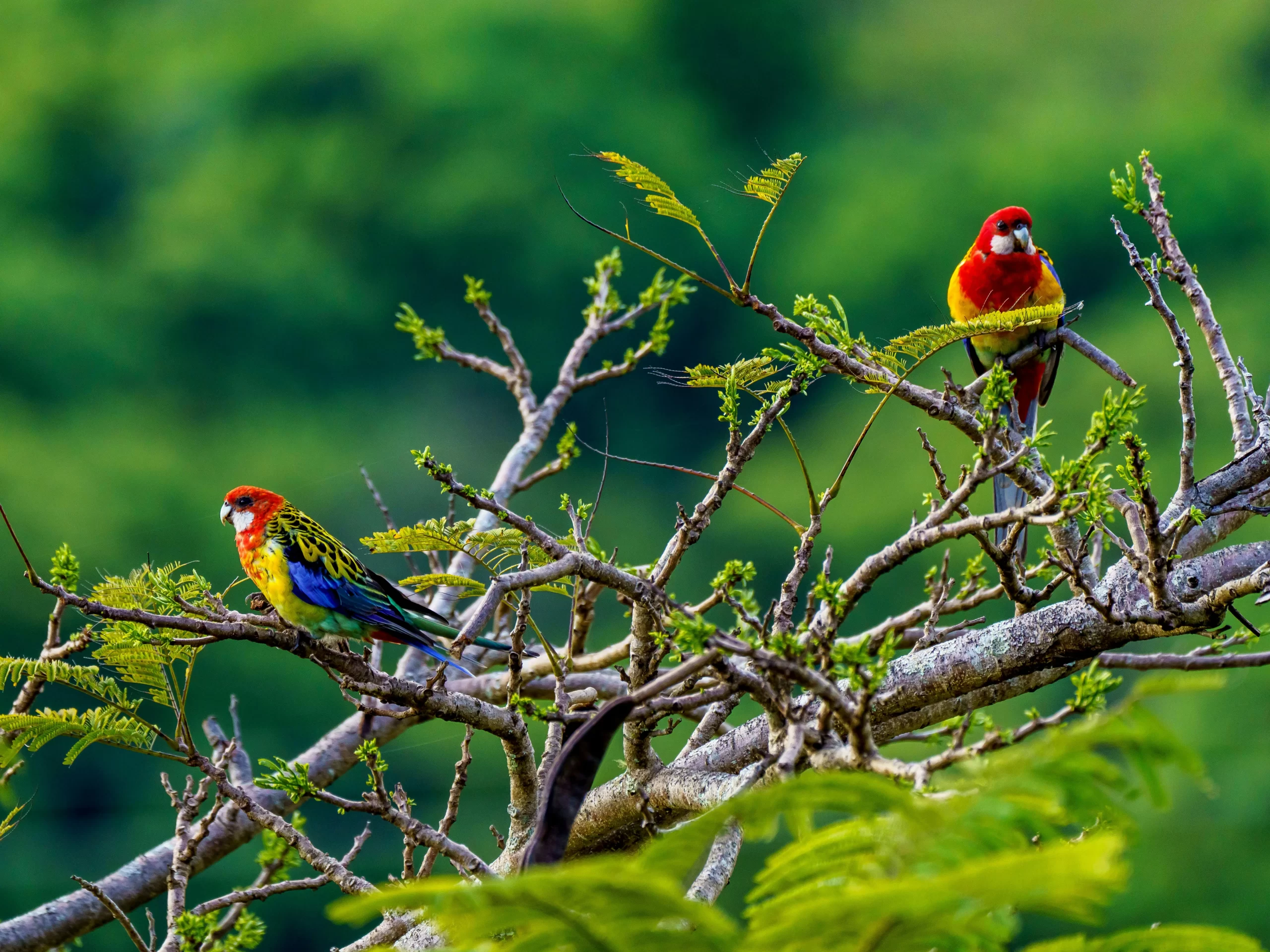Rosellas are largely unknown to much of the world, but Aussies are quite familiar with these dazzling parrots. Rosellas are among the most beautiful birds in the world, being adorned with stunning shades of blue, red, green, and yellow. Although plenty recognize the beauty of rosellas, few know many additional details about these birds. For instance, how many types of rosella birds exist?
Well, I will be investigating this question and much more within this article. I will offer you a perspective that does not portray Australian rosellas as commodities to be sold. Rather, I will describe how the types of rosellas behave and function in their native environments. Let’s get started!
Table of Contents
The 6 Types of Rosellas
Crimson Rosella
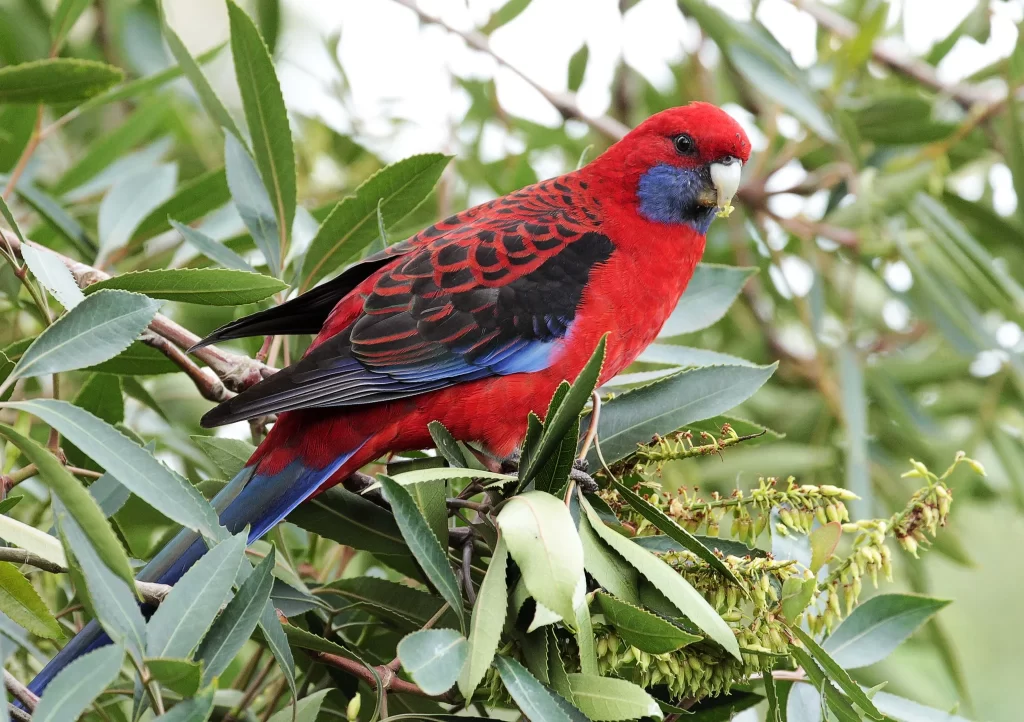
Identification
Crimson Rosellas are breathtakingly gorgeous, being perhaps the most attractive of the different types of rosellas. They are quite variable in their plumage colouration, with their bodies being red, yellow, or orange. All plumages feature blue cheek patches, blue wings, and blue tails. Immature Crimson Rosellas are largely greenish on their bodies, but they show their blue colouration.
Habitat and Range
Crimson Rosellas seek forested areas near sources of water. Therefore riparian habitats as well as forests with significant amounts of annual rainfall are favored locations for this species.
They are not common in urban environments, but birds may wander into suburbs with plenty of cover. Crimson Rosellas commonly fly out to open environments in their search for food, so these rosella types may turn up in agricultural landscapes.
The range of these rosella species is largely based in Southeastern Australia. The western extent of their distribution is around Adelaide, while their range continuously extends up to Brisbane. An isolated population exists around Port Douglas and Cairns. They’ve been introduced to New Zealand and Norfolk Island, and birds that have escaped captivity have even been spotted in Florida!
Conservation Status and Abundance
Crimson Rosella populations are thought to be more than 200,000 in totality. Their populations are rather stable, but they are threatened by habitat loss, invasive species predation, and capture for the aviculture trade.
Eastern Rosella
Identification
Eastern Rosellas look like a child took a colour palette and splattered a bunch of colours onto a bird. They have red heads with white cheeks and red collars. They’ve got yellow undersides and yellow backs with black mottling. Eastern Rosellas also have green tails with blue outer tail feathers and blue wings.
Habitat and Range
Eastern Rosellas do not seek out dense forests, rather, they prefer open areas with modest tree cover. Therefore, look for these types of rosella birds in small woodlands that are scattered throughout open, grassy areas. They may appear in parks or backyards.
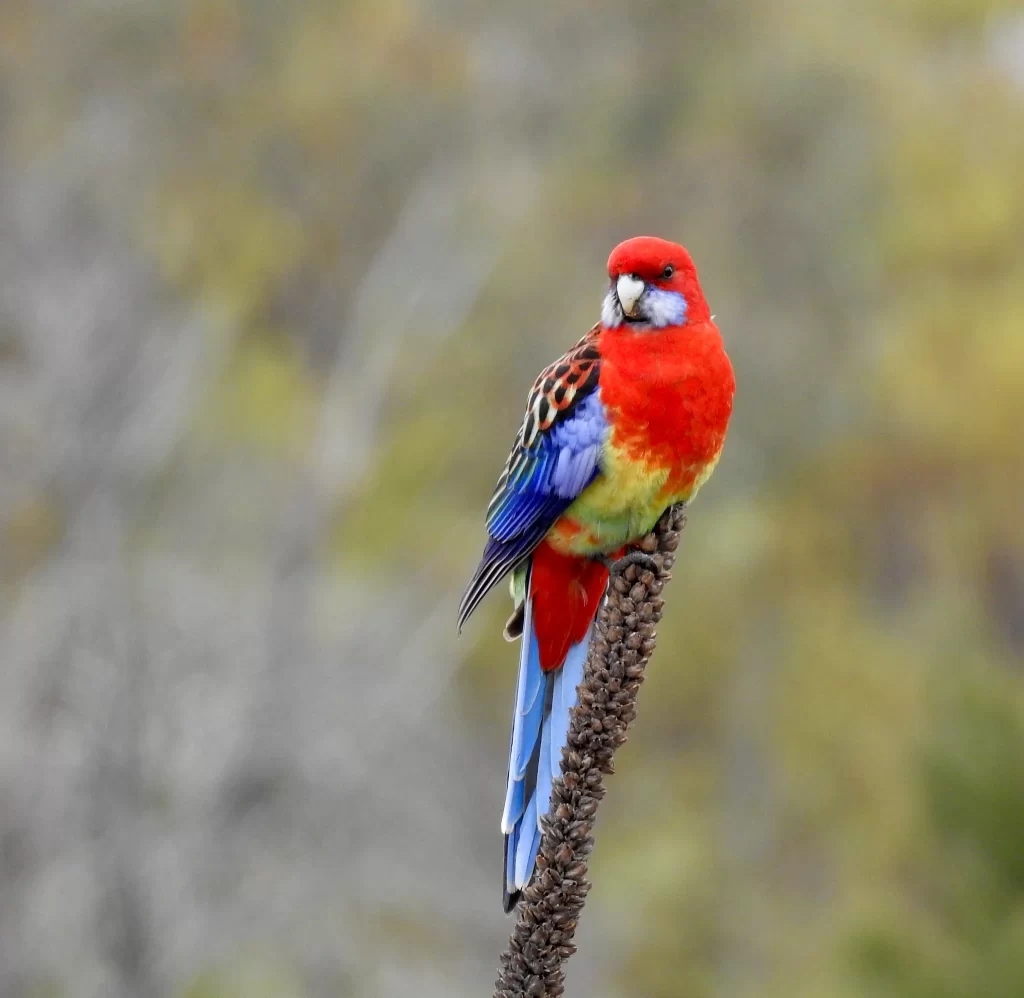
Eastern Rosellas have a similar range compared to Crimson Rosellas, as they can be found from Adelaide to Brisbane. However, they are also native to Tasmania. They’ve been introduced to New Zealand where they’ve been present for more than 100 years. Additionally, this rosella species has been found on the Cook Islands.
Conservation Status and Abundance
Eastern Rosellas are designated as a species of least concern by the International Union for Conservation of Nature (IUCN). They do not seem to face any dire threats, and–unlike some other rosella birds–they have benefited from the clearing of forested areas.
Green Rosella
Identification
Green Rosellas are appropriately named, having bodies that are largely green overall. They’ve got blue cheek patches, red foreheads, and a yellowish wash on their heads and chests. Additionally, Green Rosellas have some blue colouration on their wings and tails. Young birds look similar to adults, but they are a drab brownish colour.
Habitat and Range
The Green Rosella can be found within any type of wooded habitat in its range. These rosella bird types are not afraid to visit areas dominated by humans if adequate tree cover is present, and areas with fruit-bearing trees are often frequented. Eucalyptus trees make for an important habitat for these types of rosellas.
Green Rosellas are the only rosella that are strictly native to Tasmania. They’ve not been introduced with success to any locations at this point.
Conservation and Status
Despite their limited range, Green Rosellas have a least concern designation for the IUCN. Their populations do not seem to be threatened by any major reasons for concern at this time.
Northern Rosella
Identification
Northern Rosellas are handsome-looking parrots with pale yellow bodies that have a scaly appearance. Their wings, tails, and cheeks are bluish, while their undertail coverts are red. They’ve got mottled yellow and black backs, while their crowns are black.
Habitat and Range
Northern Rosellas are found in woodlands composed of eucalyptus trees and other sizable tree species. Their habitats tend to feature some topography, and they frequent areas with water nearby. These pretty rosella types may visit backyards and parks occasionally.
Northern Rosellas have a fairly small range, with most of their population surviving in the northern portions of the Western and Northern Territories. Their range extends from Kimbolton east to Lawn Hill. Additionally, this rosella bird has not been successfully introduced anywhere.
Conservation Status and Abundance
These rosella species are not threatened at this time, being classified as a species of least concern. However, they are regarded as uncommon birds, and they are vulnerable to landscape-level changes throughout their range.
Pale-headed Rosella
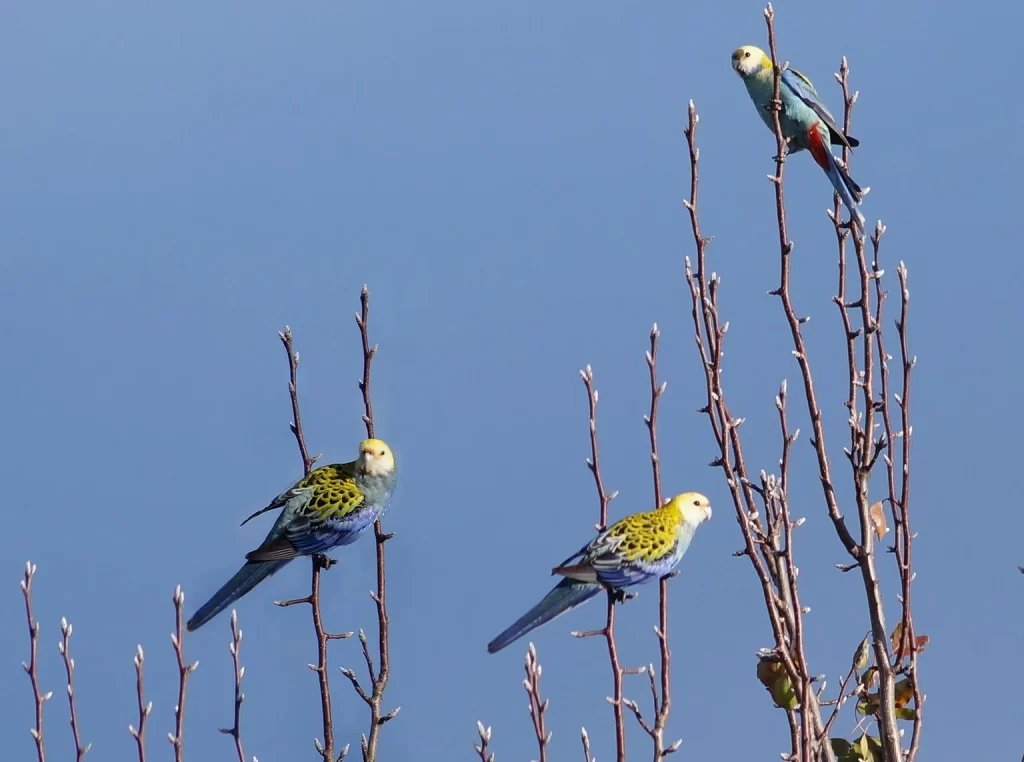
Identification
Although Pale-headed Rosellas have a name that sounds rather drab, these types of rosellas are anything but. They’ve got yellow and white heads with captivating blue undersides and wings. The mottled yellow and black backs and red undertail coverts are also hard to miss.
Habitat and Range
Pale-headed Rosellas are fairly adaptable, being present in a variety of wooded habitats throughout their range. They do not tend to be found in rainforests, instead preferring habitats that are not quite as dense. Open woodlands seem to be excellent locations for these parrots.
Most of the Pale-headed Rosella population is located within Queensland, but northwestern New South Wales hosts this species as well. Pale-headed Rosellas do not naturally occur south of Port Macquarie. They have not been introduced anywhere successfully.
Conservation Status and Abundance
This species is doing well, with no significant threats leading to population declines. They have benefitted from the growth of fruits, grains, and cereals by farmers.
Western Rosella
Identification
Western Rosellas are sexually dimorphic, being the only one of the six rosella bird types with this characteristic. Males have red heads, napes, and undersides, while their cheeks are yellow. Meanwhile, females are greenish below with drab red or green heads. Both sexes have green and black mottled backs and blue on the tails and wings. Young birds are typically orangish below.
Habitat and Range
Western Rosellas thrive in open habitats that feature modest tree growth. Open woodlands adjacent to fields or grasslands are often optimal for this species. Riparian habitats are also commonly used.
Western Rosellas have a rather small range, being restricted to far southwestern Australia. Here, they are found from Joondalup southeast to Ravensthorpe. Introduced populations do not exist anywhere.
Conservation Status and Abundance
Western Rosellas have stable numbers, but they have undergone local declines in some areas. These declines have been driven by a lack of suitable nesting habitat, as birds like larger parrots and kookaburras stake out the premium nesting locations. Moreover, persecution from farmers has driven local Western Rosella population losses despite being protected by Australian law.
What Do Rosellas Eat?
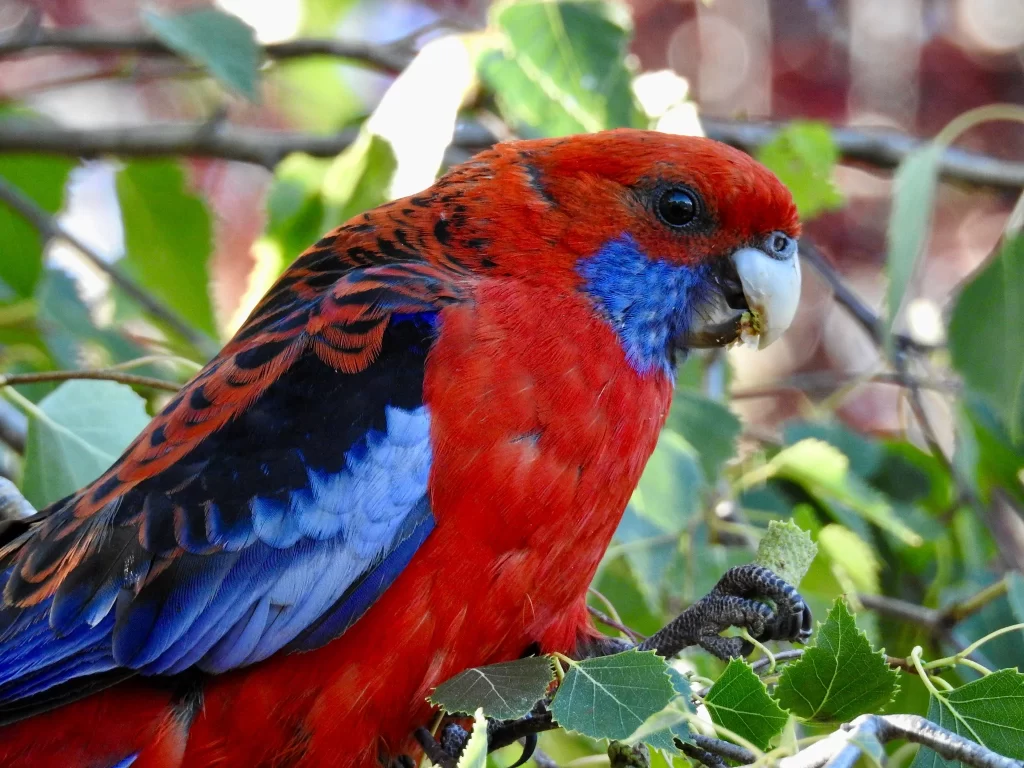
For those who read the entirety of the article, you are likely now familiar with what the different rosella types eat. However, if you missed it, let’s discuss the question further. So, what do rosellas eat?
Rosella birds consume a diet that many humans would not mind eating, as fruits, seeds, and grains are staples for these birds. They feed from a wide array of different plants, and rosellas have adapted to eating introduced cereals and fruits–much to the dismay of farmers. Food may be obtained from trees, shrubs, grasses, crops, and the ground.
Knowing about diet is one thing, but many are curious about the lifespans of rosellas. So, how long do rosellas live?
How Long Do Rosellas Live?
Those who have a pair of rosella birds that frequent their backyard may ask, “How long do rosellas live?”. Well, like many parrots, these birds can live rather long lives. Captive birds have been known to live for longer than 20 years, but wild birds rarely survive to this age due to the variety of threats that they face. However, it is not abnormal for wild birds to survive for longer than 10 years.

